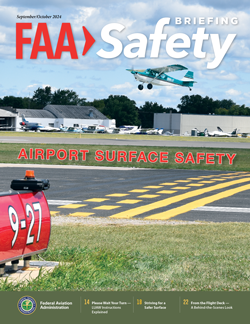Carbon Monoxide Hazards and Mitigations, Father and Son Co-Pilots, Help Improve Runway Safety
Carbon Monoxide Hazards and Mitigations
You are probably aware of the dangers of carbon monoxide (CO) in enclosed spaces like your home, but have you considered the hazards it poses while operating your aircraft? As long as aircraft burn fuel to generate power, there is a risk that CO could find its way into the cabin.
Since 2010, there have been 12 fatal accidents in which CO impairment was the primary root cause. Pre-existing damage to exhaust systems has been identified as a common element in the majority of these cases. Proper maintenance and repair of existing exhaust systems is crucial for preventing this hazard. In addition, CO detectors are another piece of the puzzle. The usage of an alerting type of CO detector makes a major difference between fatal accidents and incidents where the pilot was exposed to carbon monoxide but was able to make a safe landing. To learn more about this #FlySafe topic, go to https://medium.com/faa/carbon-monoxide-hazards-and-mitigations-in-aircraft-exhaust-systems-dc558b2493f8 and take a look at these additional resources:
“Keeping the Cabin Warm and Safe,” Nov/Dec 2023 FAA Safety Briefing medium.com/faa/keeping-the-cabin-warm-and-safe-dcc5fb4ad733.
“Carbon Monoxide: A Deadly Menace,” FAA Pilot Safety Brochure www.faa.gov/pilots/safety/pilotsafetybrochures/media/cobroforweb.pdf
“Difficult and Exhausting,” Mar/Apr 2023 FAA Safety Briefing medium.com/faa/difficult-and-exhausting-3160e6e44ab7
FAA Safety Team Online Course: Aircraft Exhaust Systems (ALC-498) www.faasafety.gov/gslac/ALC/course_content.aspx?pf=1&preview=true&cID=498
The Air Up There: Father-Son Co-Pilots
For Tom and Erik Lake, the passion for aviation runs in the family. This extraordinary father and son team has logged almost 500 hours together on the flight deck. Tom was his son’s captain when he took his first flight as a commercial airline pilot, and Erik was his dad’s First Officer on Tom’s last commercial flight. The experiences in between their career milestones created a captivating narrative of a real and rare family legacy on the flight deck. In this episode of the FAA’s podcast series The Air Up There, Erik talks about his journey into aviation through the Reserve Officers’ Training Corps and shares advice for aspiring Aviators. Tom, who has trained countless aviators, imparts his wisdom after retiring from a rewarding career. To listen to this, and other episodes of the podcast The Air Up There, go to https://www.faa.gov/podcasts/the_air_up_there.
You’re Invited to Help Improve Runway Safety
The FAA’s Runway Safety Program requires the more than 500 air traffic control facilities across the country to conduct an annual Runway Safety Action Team (RSAT) meeting. At these meetings, along with the airport operator, stakeholders, users, and other responsible airport partners, they address specific surface safety matters like airfield surface events, national and local safety data trends, planned construction and surface clousures, current issues, and evolving safety resources. When corrective actions are identified, they are tracked until completed and recorded in the Runway Safety Action Plan (RSAP). Your attendance at an RSAT meeting will help improve runway safety! To learn more about RSAT meetings and how you can attend, read “Making a Difference One Airport at a Time” at https://medium.com/faa/making-a-difference-one-airport-at-a-time-213b8f593ba8 in the Sep/Oct 2024 issue of FAA Safety Briefing. See the entire Airport Surface Safety issue at www.faa.gov/safety_briefing.
Produced by the FAA Safety Briefing editors: www.faa.gov/safety_briefing
Address questions or comments to: SafetyBriefing@faa.gov
Follow us on X (formerly known as Twitter): @FAASafetyBrief or https://twitter.com/FAASafetyBrief

